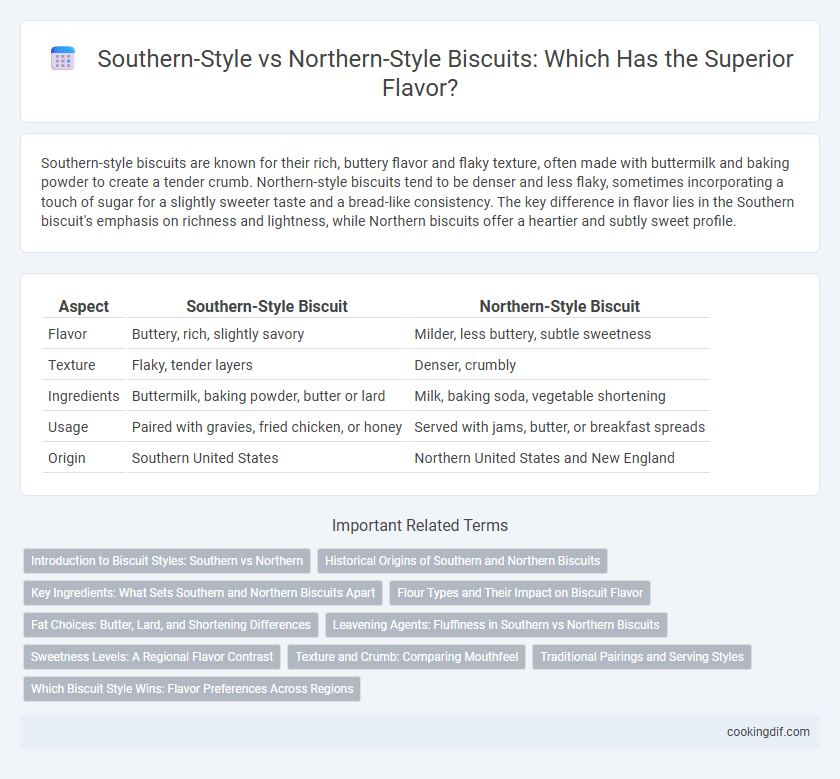Southern-style biscuits are known for their rich, buttery flavor and flaky texture, often made with buttermilk and baking powder to create a tender crumb. Northern-style biscuits tend to be denser and less flaky, sometimes incorporating a touch of sugar for a slightly sweeter taste and a bread-like consistency. The key difference in flavor lies in the Southern biscuit's emphasis on richness and lightness, while Northern biscuits offer a heartier and subtly sweet profile.
Table of Comparison
| Aspect | Southern-Style Biscuit | Northern-Style Biscuit |
|---|---|---|
| Flavor | Buttery, rich, slightly savory | Milder, less buttery, subtle sweetness |
| Texture | Flaky, tender layers | Denser, crumbly |
| Ingredients | Buttermilk, baking powder, butter or lard | Milk, baking soda, vegetable shortening |
| Usage | Paired with gravies, fried chicken, or honey | Served with jams, butter, or breakfast spreads |
| Origin | Southern United States | Northern United States and New England |
Introduction to Biscuit Styles: Southern vs Northern
Southern-style biscuits are characterized by their flaky, buttery layers and tender crumb, often made with buttermilk to enhance flavor and texture. Northern-style biscuits tend to be denser and less flaky, with a cake-like consistency and a sweeter taste profile. These regional variations reflect differing ingredient choices and baking techniques, shaping the distinct flavor and texture experiences in traditional biscuit recipes.
Historical Origins of Southern and Northern Biscuits
Southern-style biscuits trace their origins to Scottish and English settlers who brought flaky, layered bread recipes to the American South in the 18th century, creating rich, buttery, and tender biscuits using buttermilk and baking powder. Northern-style biscuits evolved from harder wheat varieties and New England recipes reliant on baking soda and sour cream, resulting in denser, less flaky textures associated with practical, hearty breads. Regional agricultural influences and cultural preferences shaped distinct biscuit flavors, with the South favoring soft, airy biscuits and the North leaning towards a more compact, cake-like consistency.
Key Ingredients: What Sets Southern and Northern Biscuits Apart
Southern-style biscuits rely heavily on buttermilk and high-fat butter or lard, giving them a tender, flaky texture and rich flavor. Northern-style biscuits often incorporate baking powder or baking soda as primary leavening agents, resulting in a denser, bread-like crumb. The distinct use of fat types and leavening methods defines the key ingredient differences that influence flavor and texture in each regional biscuit style.
Flour Types and Their Impact on Biscuit Flavor
Southern-style biscuits typically use low-protein soft wheat flour, resulting in a tender, flaky texture and a delicate, buttery flavor. Northern-style biscuits often incorporate higher-protein hard wheat flour, which produces a denser, chewier texture with a nuttier, more robust taste. The protein content in the flour directly impacts gluten development, influencing both the biscuit's crumb structure and overall flavor profile.
Fat Choices: Butter, Lard, and Shortening Differences
Southern-style biscuits often rely on lard or butter, delivering a richer, flakier texture with a pronounced savory flavor, while Northern-style biscuits typically use vegetable shortening for a lighter, more tender crumb with a subtle taste. Butter contributes a creamy, natural richness that enhances flavor depth, lard offers exceptional flakiness and a slightly meaty profile, and shortening provides consistent texture and extended shelf life without overpowering the biscuit's flavor. Understanding these fat choices allows bakers to tailor biscuit characteristics, balancing moisture, flakiness, and flavor intensity in regional variations.
Leavening Agents: Fluffiness in Southern vs Northern Biscuits
Southern-style biscuits rely primarily on baking powder and buttermilk for leavening, creating a tender, flaky texture with pronounced fluffiness. Northern-style biscuits often incorporate baking soda and sometimes yeast, resulting in a denser, chewier consistency with less rise. The choice and combination of leavening agents directly influence the biscuit's crumb structure and moisture retention, defining regional flavor and texture distinctions.
Sweetness Levels: A Regional Flavor Contrast
Southern-style biscuits typically feature a subtle sweetness that complements their buttery, flaky texture, often enhanced by a touch of sugar or honey. Northern-style biscuits lean towards a more neutral or savory profile, emphasizing a bread-like flavor with minimal sweetness. This regional contrast in sweetness levels reflects distinct culinary traditions and ingredient preferences across the United States.
Texture and Crumb: Comparing Mouthfeel
Southern-style biscuits feature a tender, flaky texture with a soft, layered crumb that melts in the mouth, achieved through the use of cold butter and buttermilk. Northern-style biscuits tend to have a denser, more bread-like crumb with a chewier mouthfeel, often resulting from higher kneading and less fat. The contrast in texture and crumb significantly influences the eating experience, with Southern biscuits prized for their lightness and Northern varieties noted for their hearty chew.
Traditional Pairings and Serving Styles
Southern-style biscuits, known for their flaky texture and buttery flavor, are traditionally paired with savory dishes like gravy, fried chicken, or ham, enhancing their rich taste profile. Northern-style biscuits tend to be denser and less flaky, often served with sweet accompaniments such as jam or honey, complementing their slightly sweeter dough. Serving styles also differ as Southern biscuits are commonly split and topped with gravy or butter, while Northern biscuits are typically served whole or sliced with sweet spreads.
Which Biscuit Style Wins: Flavor Preferences Across Regions
Southern-style biscuits are renowned for their flaky, buttery texture and slightly tangy flavor due to buttermilk, appealing to those who prefer rich, savory profiles. Northern-style biscuits, often denser and sweeter with a hint of vanilla or sugar, cater to a palate favoring dessert-like qualities. Flavor preferences across regions typically favor Southern-style biscuits in the South for their traditional comfort food status, while Northern consumers lean towards the sweeter, cake-like Northern biscuits.
Southern-style vs Northern-style for biscuit flavor Infographic

 cookingdif.com
cookingdif.com